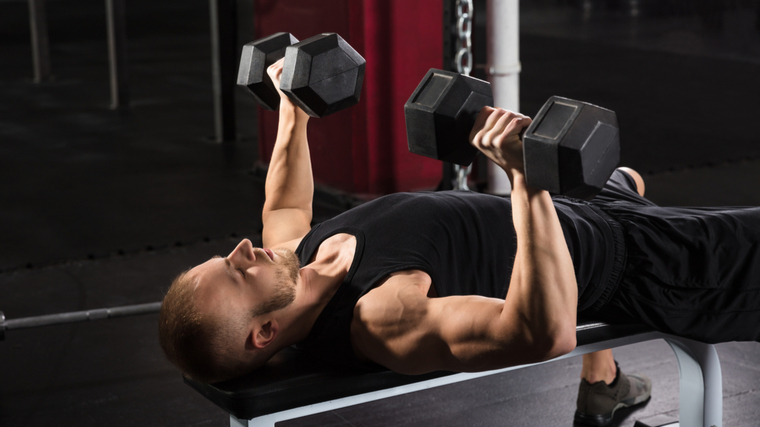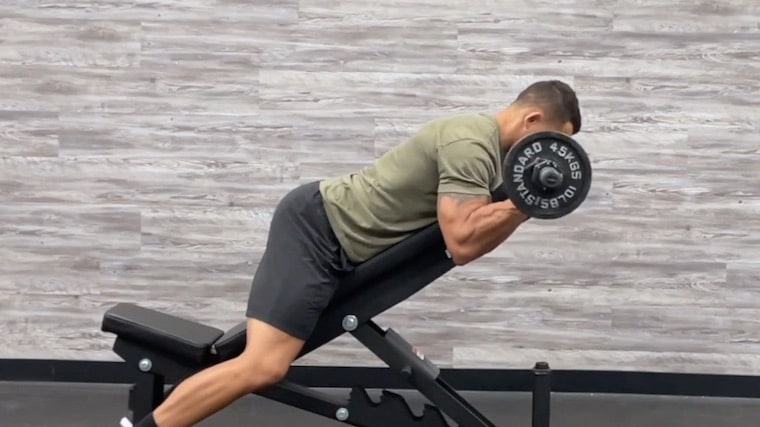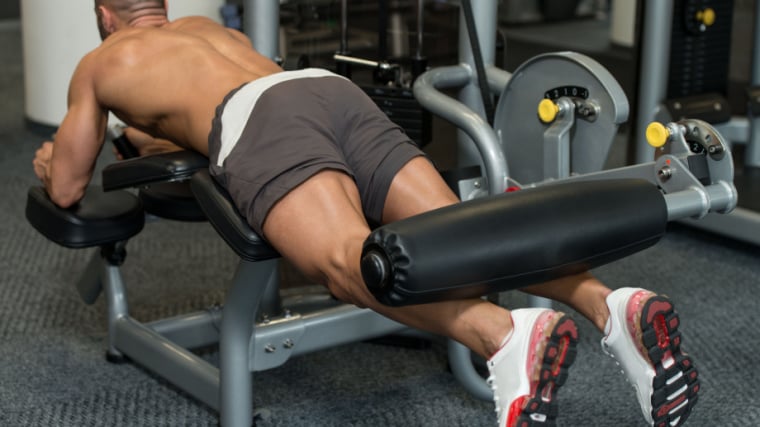In the world of fitness, lifting with a partial range of motion is often considered blasphemy. There’s been an ongoing war waged between coaches, lifters, and fitness gurus about proper exercise technique. For many, anything short of a full range of motion is ineffective and off limits. But, as time and science have proven, strategically manipulating the range…
The post Partial Reps — How to Use Short-Range Movements for Maximum Results appeared first on Breaking Muscle.
In the world of fitness, lifting with a partial range of motion is often considered blasphemy. There’s been an ongoing war waged between coaches, lifters, and fitness gurus about proper exercise technique. For many, anything short of a full range of motion is ineffective and off limits.

But, as time and science have proven, strategically manipulating the range of motion can actually be very beneficial. (1) Partial reps can be useful for improving strength or size, allowing a seasoned lifter to push beyond muscular failure, overload the target muscle (or the nervous system), or even emphasize a specific portion of the range of motion to overcome sticking points.
If you’re a relatively experienced lifter ready to unlock new gains, here are some science-backed methods to implement this intensity-boosting technique.
Guide to Partial Reps
- How Partial Reps Work
- How to Perform Partial Reps
- Partial Reps vs. “Cheating”
- Benefits of Partial Reps
- Programming Recommendation for Partial Reps
How Partial Reps Work
Partial reps can be used either as a consistent training method or as an occasional intensity-boosting technique. As an intensity technique, they allow the lifter to push beyond failure by performing half-repetitions when you don’t have the strength necessary to keep using a full range of motion (ROM) anymore. This can be useful because, unlike forced reps, you don’t need a training partner and, unlike drop sets, you don’t need to reduce the weight you’re lifting.
The fatigue generated by reaching technical failure will ensure that the partial reps recruit all the involved motor units (neurons commanding the muscles) while providing muscular tension. (2) This can provide a fantastic hypertrophy stimulus as you increase metabolic stress and effective repetitions. (3)

You can also train with more volume in a relatively short time, which can be a life saver when training time is limited. The drawback is that this technique, like many other intensity techniques, can generate a high level of fatigue and should be used sparingly and by relatively advanced lifters.
As a more frequent training method, partial reps consist of performing a specific section of the range of motion on all repetitions of a given exercise. It’s a powerful way to stimulate a muscle and trigger growth with single-joint (isolation) exercises, like seated barbell curls, or to improve strength in a multi-joint (compound) exercise, like squats, by using heavier than normal weight and stressing the nervous system into adapting.
How to Perform Partial Reps
To emphasize muscle growth, perform full range of motion, high-quality repetitions until you reach muscular failure or a predetermined number of repetitions. Immediately continue the set by performing half-range of motion repetitions to failure or, again, until a specific number of reps are completed.
To focus on strength, perform partial reps in the specific range of motion you need to target — either the sticking point presenting the biggest obstacle or your strongest position (typically near lockout) to overload the exercise.
This can be done either cutting the movement short under your own control or by using external supports such as pins or a box (in the cases of presses and squats, respectively). There are often specific exercise variations taking advantage of the partial range of motion, for instance, the floor press or rack deadlift.
The exact way to implement partial reps will depend on the exercise being performed, as the curve of resistance (where in the range of motion it is most challenging) differs between movements. Generally, you want to keep doing half-reps in the less challenging range of motion once you can’t do any more complete repetitions, otherwise you won’t be able to do much afterwards if you perform go to failure in a short ROM before performing a full ROM.
In any case, don’t change your exercise technique or shift the stress to another body part when doing partial reps — perform the same movement, simply with a shorter range of motion.
Emphasize the Contraction or the Stretch
With most exercises, you can do partials in either the stretched (lengthened) or contracted (shortened) position. Each option will have a slightly different effect and might not correlate with the moment arm of the exercise.
For example, compare the shortened position of the quadriceps during the back squat and the leg extension. The contracted position in both exercises is at the top of the movement, but it is a very easy part of the movement with the squat, while it is grueling to hold the top of the leg extension.
The majority of the time, emphasizing the lengthened portion of an exercise is superior for hypertrophy, so you might want to focus on pumping out partial reps closer to the stretched position for maximal muscle gains.
However, with some exercises like the preacher curl, the stretched position is also relatively more dangerous and more difficult phase of the exercise — you would not be able to do many partial reps, if any, and you would risk injuries. Focusing on the contracted position, on the other hand, can provide a nasty pump and vastly improve the mind-muscle connection.

For exercises that emphasize the shortened range — when you can easily feel a strong contraction in the target muscle, like your glutes during the hip thrust — do your partial reps in that same range.
For exercises that favor the lengthened range and feel most difficult in the stretched position, like the leg curl or pull-up, do your partials in the stretched position. It wouldn’t make much sense to do partials in the bottom of a hip thrust when there’s minimal tension on the target muscle. Instead, use partials to further emphasize the strong point of an exercise and really squeeze at the top.
Partial Reps vs. “Cheating”
Cheating during an exercise is when you change the technique of an exercise to make it easier, often to allow more weight or extra repetitions than you could do with strict form. It could be using body english and swinging your body or by cutting the range of motion short.
The term “cheating” is inherently negative because letting your ego take control at the sake of form will only increase joint stress, reduce progress, and potentially cause injuries. (4) Many gym veterans are familiar with seeing quarter-squats performed by someone with shaky knees just to put on more plates on the bar. But just like partial reps, cheating can also be beneficial in certain instances, if properly applied. (5)

So, how are partial reps any different? Partials are executed to make the exercise harder, not easier, or they’re used strategically to target a specific range of motion. They are done not out of ego, but to better reach your muscle- or strength-building goals.
For instance, let’s get back to the quarter squat — it’s actually one of the best exercises to increase sprinting speed. (6) So, if you’re an athlete, it can be a great choice, but it won’t be as useful if you’re trying to grow your quads. Similarly, if you’re doing quarter squats because you just want to have 300 pounds on the bar no matter what the reps look like… that’s cheating.
Benefits of Partial Reps
Partial reps can be beneficial for size or strength, and help you bust through plateaus. The most efficient methods can differ slightly based on your goal, so here’s what to know before diving in.
More Muscle Gains
Partial reps are most often used for hypertrophy, as they are particularly efficient for putting on more muscle mass. Yes, you’re usually told to only perform an exercise with pristine form and a full range of motion, but the truth is never that simple with the human body. In fact, you can even grow muscle performing only partial repetitions. (7)
Muscles grow as an adaptation of mechanical tension, and this tension does not always equal with the range of motion. For instance, you could perform Romanian deadlifts and have your hamstrings fully stretched with the barbell at knee-level, while still being able to lower the weight farther. Most of the time, a full range of motion equals the muscle’s full functional range, but it’s not always the case depending on the body part and exercise.
The mechanisms of hypertrophy have proven that the range of motion is not the be-all, end-all. One particular study compared the lying leg curl and the seated leg curl. (8) Both exercises were done with a full ROM, but the seated leg curl was found to be more efficient for muscle growth because it put the muscle though a greater stretch.

Partials allow you to spend more time in the lengthened muscle position, which can trigger more hypertrophy. The physiological response of partial reps is even more important, generating more intramuscular hypoxia (oxygen-related stimuli within the muscle), as well as metabolites such as lactic acid, which have been theorized to promote hypertrophy. (9)
When used as an intensity-boosting technique to go beyond failure, partials might be especially valuable for more advanced lifters to create a robust stimulus for new muscle growth, or to get away with a relatively lower number of high-intensity sets which can help with overall program design.
Going beyond failure may increase testosterone and growth hormone levels, which can be invaluable for size and strength, but the technique can also lead to higher cortisol levels (the stress hormone), so recovery can be more difficult. (10) As such, use this technique more sparingly.
Finally, extending the set can help you recruit more muscle fibers for more size. (11) When you’re doing a moderate to heavy set, your body will require fast-twitch fiber muscles to move the load. The physiological effects vary whether you’re doing heavy sets of five or relatively lighter sets of ten. But, going beyond failure with partial reps will force all of the slow-twitch muscle fibers to be recruited and assist in the exercise. More muscle stimulated equals more gains.
Increasing Strength
When doing partial reps, you can lift more weight than using full ROM because you’re moving that weight across a shorter range of motion. This can be used as a direct neural stimulus to improve strength and gradually ease the body into lifting heavier weights in a full ROM. (12) It can be a great strategy to use in a strength-dedicated training phase.
Moreover, strength is a skill, and partials are amazing for learning it. For instance, a lifter could have a very strong barbell bench press but be much less impressive with squats. You can use this method to separate a complex movement into different steps or to focus on a specific portion of the lift you’re weaker in.
If you’re terrible at the lockout of the bench press, doing partials focusing in the end-range of the exercise, or using a specific exercise like the floor press which emphasizes the lockout position, will help to build your triceps and improve that end-range strength. You could even incorporate a progressive range of motion strategy — use partial reps and gradually increase the range of motion of an exercise week after week, until you master the movement and can perform a full ROM.

This is also an excellent strategy for lifters lacking in the mobility department or those that are just learning a movement. Starting easy and building over time will improve the coordination, mobility, and confidence needed to properly perform the exercise. Finally, if you’ve suffered an injury and need to work around problematic joint pain, you can stick to the range of motion that doesn’t hurt while still benefitting from a training stimulus.
How to Program Partial Reps
As there are many different programming possibilities depending on your goals, here are the best strategies to maximize your progress using partial reps. You need to take into consideration the recovery cost of such techniques, and bear in mind that beginners should avoid these high-intensity strategies until they’re more experienced.
Exercise Selection
As an intensity-boosting technique, you should mainly stick to isolation (single-joint) exercises. When using compound exercises, the accumulated fatigue and risk of injury can be too high. There’s also the probability of altering technique, which will result in decreased motor control and a poor progression rate. The nature of the exercise and the curve of resistance can also make it hard to focus on the primary target muscles.
Lower body favorites for partial reps include leg extensions, leg curls, and calf raises. For upper body, consider curls, triceps cable extensions, the cable pullover, and lateral or bent-over raises. You can also consider any exercise where you feel you can safely go beyond failure without altering the technique and risking injury.

A case could be made for some relatively safer multi-joint exercises, for instance the hip thrust, lat pulldown, hack squat, or various machine rows. You should never try partial reps on an exercise that loads your spine like the squat or the deadlift unless you’re very experienced. Even in that case, the stimulus to fatigue ratio and potential risk of injury often won’t be worth it.
If you want to perform only partial reps without cranking up the intensity to the max, you can use this technique on virtually any exercise. But first make sure that you can correctly perform the exercise with a full range of motion and really understand the mechanics of the movement beforehand so, again, beginners should generally refrain from such work.
Partials as High Intensity Technique
This is the most brutal and fun use of partials — using them to extend a set after being fatigued from full ROM reps, to enhance the hypertrophy stimulus. Theoretically, you could do many, many partial reps in a set beyond failure, but the recovery cost would be through the roof. So, it’s best to never go beyond doubling your reps per set when using in partials.
A good rule of thumb, to strike a balance between intense training and acceptable recovery, would be to perform partials for half as many reps as the preceding full ROM. For instance, ten full range of motion reps followed by five, no more than ten, partial reps. As for the number of sets, you should only do these on the last set of an exercise for two to four total sets per session, otherwise your overall recovery and capacity to perform for the remaining workout could be severely compromised.
You could use this technique frequently during a short, “blitz” period to force growth, but generally respect 48 to 72 hours of rest between sessions when using intensity techniques to go beyond failure. As such, don’t use them in every session of the week issues.
Partials as a Training Method
This applies when you’re doing partials for all the repetitions of the set, or using a partial ROM exercise like the seated barbell curl or floor press, to overload the muscles and provide a new stimulus that will shock your body into growth.
Keep the load on the relatively heavier side of the hypertrophy range to really take advantage of the improved power output, and aim for two to four sets of six to 10 repetitions.
You can also use partials to really shock the muscle by using a heavy weight for high reps, two to three sets of 15 to 20 reps. This is a great method to use with muscles which you never or can’t usually use heavy weights, like a partial lateral raise to build up your side delts.
Finally, this can be an excellent and effective method for building strength. Avoid isolation exercises and either execute partial reps on a big basic exercise like an overhead press, or a multi-joint, partial-range exercise like the box squat. For absolute strength gains, three to five sets of one to five repetitions with ample rest works best. You can also bump up the reps a bit when focusing specifically on a weak muscle that’s preventing you from increasing your lift by using sets of five to eight.
Periodizing Partial Reps
Because partial reps can bear a heavy toll on your body’s recovery, you should use them sparingly and plan ahead for best results… or just throw them here and there for fun.
As an muscle-building intensity technique, they’re best used in a high-intensity training period of four to six weeks, followed by a relatively easier block of training to recover, compensate, and grow.
Another great way of introducing them would be to cycle the number of sets per session that use partials. For instance, the first week, use partial reps in one set per session. The next week, you increase this number to two sets, then three sets, followed by four sets, and finally a deload without any partials.

Finally, you can also use this method as a fun and stimulating method of progression, to increase your workload over subsequent sessions. For instance, on your last set of leg curls, you could do ten full reps followed by ten partials in the stretch position. Then, next session, bump up the number of partials to 15. Eventually, in the third session, increase it again to 20 partial reps. Then, reset the progression model with a slightly heavier weight.
If you’re using partial reps as a training method for strength or size, then it’s even more simple. It would be best to stick to a three to six-week block using partial reps before rotating to a less intense training block. Though, if you’re using them to bring up a lagging muscle group, you could use the technique for a longer period.
Partial Reps For Complete Gains
Often deemed as “improper form” or ego-driven, partial reps can be perfectly acceptable and highly efficient for promoting size and strength. The key is to program the technique with a specific purpose in mind. Set aside your range of motion-based prejudices and give partial reps a chance in your training. You won’t be disappointed.
References
- Pedrosa GF, Lima FV, Schoenfeld BJ, Lacerda LT, Simões MG, Pereira MR, Diniz RCR, Chagas MH. Partial range of motion training elicits favorable improvements in muscular adaptations when carried out at long muscle lengths. Eur J Sport Sci. 2022 Aug;22(8):1250-1260. doi: 10.1080/17461391.2021.1927199. Epub 2021 May 23. PMID: 33977835.
- Potvin JR, Fuglevand AJ. A motor unit-based model of muscle fatigue. PLoS Comput Biol. 2017 Jun 2;13(6):e1005581. doi: 10.1371/journal.pcbi.1005581. PMID: 28574981; PMCID: PMC5473583.
- Schoenfeld BJ. The mechanisms of muscle hypertrophy and their application to resistance training. J Strength Cond Res. 2010 Oct;24(10):2857-72. doi: 10.1519/JSC.0b013e3181e840f3. PMID: 20847704.
- Faigenbaum AD, Myer GD. Resistance training among young athletes: safety, efficacy and injury prevention effects. Br J Sports Med. 2010 Jan;44(1):56-63. doi: 10.1136/bjsm.2009.068098. Epub 2009 Nov 27. PMID: 19945973; PMCID: PMC3483033.
- Arandjelović, O. Does cheating pay: the role of externally supplied momentum on muscular force in resistance exercise. Eur J Appl Physiol 113, 135–145 (2013). https://doi.org/10.1007/s00421-012-2420-y
- Rhea, Matthew & Kenn, Joseph & Peterson, Mark & Massey, Drew & Simão, Roberto & Marín, Pedro & Favero, Mike & Cardozo, Diogo & Krein, Darren. (2016). Joint-Angle Specific Strength Adaptations Influence Improvements in Power in Highly Trained Athletes. Human Movement. 17. 10.1515/humo-2016-0006.
- Schoenfeld BJ, Grgic J. Effects of range of motion on muscle development during resistance training interventions: A systematic review. SAGE Open Med. 2020 Jan 21;8:2050312120901559. doi: 10.1177/2050312120901559. PMID: 32030125; PMCID: PMC6977096.
- Maeo S, Huang M, Wu Y, Sakurai H, Kusagawa Y, Sugiyama T, Kanehisa H, Isaka T. Greater Hamstrings Muscle Hypertrophy but Similar Damage Protection after Training at Long versus Short Muscle Lengths. Med Sci Sports Exerc. 2021 Apr 1;53(4):825-837. doi: 10.1249/MSS.0000000000002523. PMID: 33009197; PMCID: PMC7969179.
- Goto M, Maeda C, Hirayama T, Terada S, Nirengi S, Kurosawa Y, Nagano A, Hamaoka T. Partial Range of Motion Exercise Is Effective for Facilitating Muscle Hypertrophy and Function Through Sustained Intramuscular Hypoxia in Young Trained Men. J Strength Cond Res. 2019 May;33(5):1286-1294. doi: 10.1519/JSC.0000000000002051. PMID: 31034463.
- Ahtiainen JP, Pakarinen A, Kraemer WJ, Häkkinen K. Acute hormonal and neuromuscular responses and recovery to forced vs maximum repetitions multiple resistance exercises. Int J Sports Med. 2003 Aug;24(6):410-8. doi: 10.1055/s-2003-41171. PMID: 12905088.
- Willardson, Jeffrey M PhD, CSCS1; Norton, Layne2; Wilson, Gabriel MS, CSCS2. Training to Failure and Beyond in Mainstream Resistance Exercise Programs. Strength and Conditioning Journal 32(3):p 21-29, June 2010. | DOI: 10.1519/SSC.0b013e3181cc2a3a
- Massey CD, Vincent J, Maneval M, Moore M, Johnson JT. An analysis of full range of motion vs. partial range of motion training in the development of strength in untrained men. J Strength Cond Res. 2004 Aug;18(3):518-21. doi: 10.1519/13263.1. PMID: 15320644.
Featured Image: Monkey Business Images / Shutterstock
The post Partial Reps — How to Use Short-Range Movements for Maximum Results appeared first on Breaking Muscle.






